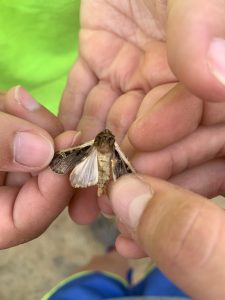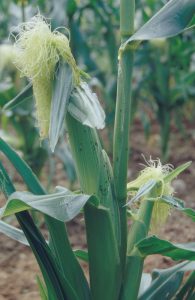Sweet Corn IPM Newsletter No. 7 — July 26, 2024
FALL ARMYWORM PRESSURE INCREASING
Western Bean Cutworm Moth Counts at Highest Levels Seen
SITUATION

Corn harvest is coming into full swing. Corn earworm numbers have moderated in some locations but fall armyworm and western bean cutworm numbers were generally higher, meaning silking corn in nearly all location requires protection.
European corn borer: No moths were caught in pheromone traps this week, indicating that the first generation of this pest is probably done for the season and presently is not a threat to silking corn. However, there are still larvae active in some fields, so we continue to look for feeding damage in pre-tassel to tassel stage corn. Larval feeding damage was under threshold at all sites, but when combined with fall armyworm damage several were over the spray threshold (see Fall armyworm below).
Corn earworm: Moth captures this week were lower at some locations, but most sites remain on a spray interval for all fresh silking corn. A 6-day spray interval for silking corn was recommended in Bowdoinham, Dayton, Gray, Palmyra one Lewiston site and Oxford; A 5-day spray interval was recommended in Biddeford and one Wells site; a 4-day spray interval was recommended for Cape Elizabeth, one Wells site and one Lewiston site.
Fall armyworm: Captures of moths continue to increase at most locations this week. Sites in Biddeford, Cape Elizabeth, Dayton, Gray, Lewiston, Wayne and Wells were over the three-moth threshold for silking corn in pheromone traps, but only the field in Wayne was not already under a spray interval for corn earworm. Larval feeding damage was generally higher on pre-silking corn. This should be combined with any European corn borer injury when found. A threshold of 12-15% of plants with fresh injury is used to determine if a spray should be applied. Combined feeding damage was over the threshold at Biddeford, and one Lewiston location.
Western Bean Cutworm: Moth numbers were generally higher this week, ranging from 0 to over 100 moths in a trap. We have added a western bean cutworm (WBC) column to the table below to show readers population numbers and distribution. However, there are no tested thresholds for moths in silking corn at this time, so we are defaulting to the threshold for fall armyworm, which is similar in habit and distribution. Sprays for corn earworm or fall armyworm should protect silking corn from western bean cutworm.
Squash vine borer: Moth numbers in pheromone traps are generally lower this week, but were over the control threshold at a few locations. Sprays to protect squash plants from egg laying moths were recommended in Wells, New Gloucester and Lewiston. See the New England Vegetable Management Guide for control options.

Corn leaf aphids have been observed in several fields this week. Aphids often infest corn plants in fields that have not recently been sprayed for other pests. Colonies of these small, bluish-green insects can cover the tassels, stalks and husks. The waste aphids excrete on the plants, called “honeydew” stimulates the development of sooty mold. This dark, slimy fungus coats the surface of the husks, reducing the marketability of the ears. Sprays applied for corn earworm usually control aphids. Sprays specifically for aphids would only be recommended if sooty mold is becoming a problem.
Sincerely,
David T. Handley
Vegetable & Small Fruit Specialist
Highmoor Farm
P.O. Box 179
52 U.S. Route 202
Monmouth, ME 04259
207.933.2100
UMaine Extension Diagnostic Research Lab
Pest Management Unit
17 Godfrey Drive
Orono, ME 04473
1.800.287.0279
| Location | CEW Moths | ECB Moths | FAW Moths | WBC Moths | %Feeding Damage | Recommendations / Comments |
|---|---|---|---|---|---|---|
| Biddeford | 5 | 0 | 11 | 21 | 48% | 5-day spray interval for silking corn |
| Bowdoinham | 3 | 0 | 0 | 7 | 9% | 6-day spray interval for silking corn |
| Cape Elizabeth | 13 | 0 | 40 | 31 | 7% | 4-day spray interval for silking corn |
| Dayton | 3 | 0 | 6 | 24 | 8% | 6-day spray interval for silking corn |
| Farmington | 0 | 0 | 1 | 75 | 0% | One spray for WBC on all silking corn |
| Garland | 0 | 1 | 1 | No spray recommended | ||
| Gray | 3 | 0 | 24 | 44 | 3% | 6-day spray interval for silking corn |
| Lewiston | 16 | 0 | 8 | 0 | 6% | 4-day spray interval for silking corn |
| Lewiston II | 3 | 0 | 6 | 109 | 15% | 6-day spray interval for silking corn |
| Oxford | 2 | 0 | 2 | 89 | 2% | 6-day spray interval for silking corn |
| Palmyra | 2 | 1 | 0 | 6-day spray interval for silking corn | ||
| Wayne | 0 | 0 | 3 | 104 | 0% | One spray for FAW and WBC on all silking corn |
| Wells I | 51 | 0 | 5 | 26 | 5% | 4-day spray interval for silking corn |
| Wells II | 4 | 0 | 19 | 8 | 3% | 5-day spray interval for silking corn |
CEW: Corn earworm (Only fresh silking corn should be sprayed for this insect.)
ECB: European corn borer
FAW: Fall armyworm
CBW: Western bean cutworm
| Moths caught per week | Moths caught per night | Spray Interval |
|---|---|---|
| 0.0 to 1.4 | 0.0 to 0.2 | No spray |
| 1.5 to 3.5 | 0.3 to 0.5 | Spray every 6 days |
| 3.6 to 7.0 | 0.6 to 1.0 | Spray every 5 days |
| 7.1 to 91 | 1.1 to 13.0 | Spray every 4 days |
| More than 91 | More than 13 | Spray every 3 days |
Thresholds apply only to corn with exposed fresh silk. Lengthen spray intervals by one day if maximum daily temperature is less than 80°F.
European Corn Borer Thresholds
Whorl stage: 30% or more of plants scouted show injury.
Pre-tassel-silk: 15% or more of plants scouted show injury.
Silk: 5 or more moths caught in pheromone traps in one week.
IPM Web Pages:
Explore Integrated Pest Management in Maine — UMaine
Integrated Pest Management Data Visualization Tool — Penn State
Integrated Pest Management — UMass Amherst
Where brand names or company names are used, it is for the reader’s information. No endorsement is implied nor is any discrimination intended against other products with similar ingredients. Always consult product labels for rates, application instructions and safety precautions. Users of these products assume all associated risks.
In complying with the letter and spirit of applicable laws and pursuing its own goals of diversity, the University of Maine System does not discriminate on the grounds of race, color, religion, sex, sexual orientation, transgender status, gender, gender identity or expression, ethnicity, national origin, citizenship status, familial status, ancestry, age, disability physical or mental, genetic information, or veterans or military status in employment, education, and all other programs and activities. The University provides reasonable accommodations to qualified individuals with disabilities upon request. The following person has been designated to handle inquiries regarding non-discrimination policies: Director of Equal Opportunity, 5713 Chadbourne Hall, Room 412, University of Maine, Orono, ME 04469-5713, 207.581.1226, TTY 711 (Maine Relay System).
